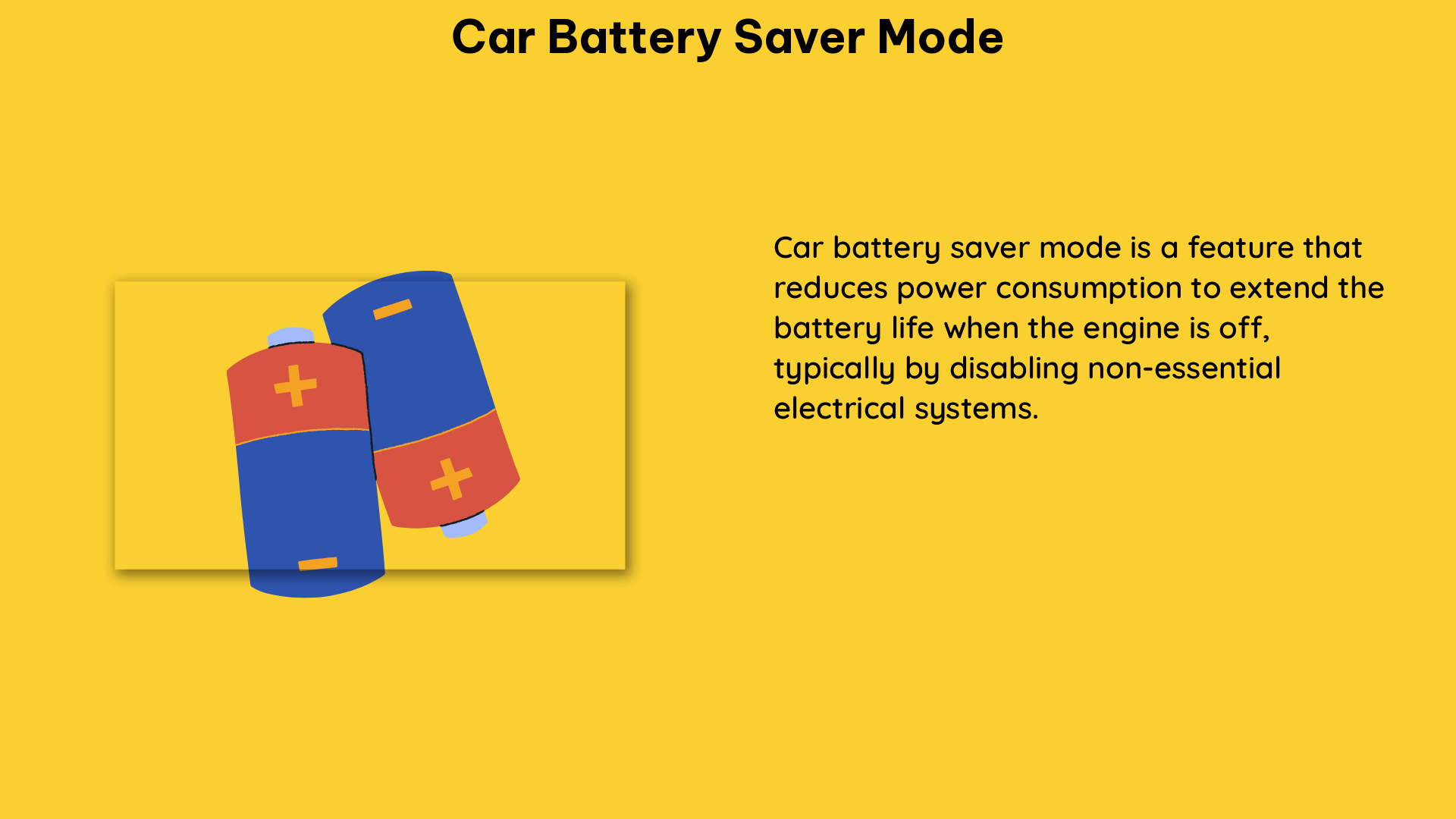The “Battery Saver Mode” or “Battery Saver On” message is a feature in modern vehicles that helps prevent the battery from draining by turning off certain electrical functions when the battery voltage drops below a critical level. This mode is activated when the battery voltage drops below 12.4 volts, as detected by a sophisticated battery sensor that monitors and regulates the electric flow in the vehicle’s charging system.
Understanding the Mechanics of Car Battery Saver Mode
The battery sensor in your car measures the net voltage, which is the electric flow supplied to the alternator and drawn by the various car accessories. When the car accessories draw more current than what the alternator can supply, a constant negative current is detected, triggering the battery saver mode.
This mode is designed to protect the battery from being completely drained, which can lead to starting issues, electrical system malfunctions, and even permanent battery damage. By turning off non-essential electrical components, the battery saver mode helps maintain a sufficient charge to ensure the vehicle can still be started and the essential systems can continue to function.
Technical Specifications of Car Battery Saver Mode
| Specification | Value |
|---|---|
| Activation Voltage | 12.4 volts |
| Voltage Measurement | Net voltage (alternator supply vs. accessory draw) |
| Trigger Condition | Constant negative current detected (accessories draw more than alternator supplies) |
| Purpose | Prevent battery drain by turning off non-essential electrical components |
Troubleshooting the Battery Saver Active Warning

When the “Battery Saver Active” warning appears on your dashboard, it’s crucial to address the underlying issue promptly to restore normal operation and prevent further battery drain. Here’s a step-by-step guide to troubleshooting the problem:
1. Inspect the Charging System Connections
Start by thoroughly inspecting the connections and cables in the charging system. Look for any signs of corrosion, loose connections, or damaged wiring. Ensure that all the connections are tight and free of any issues that could impede the flow of electricity.
2. Test the Battery
Using a digital multimeter, check the battery’s state of charge. A healthy battery should be able to hold a charge and maintain a voltage of at least 12.6 volts when the engine is off. If the battery is not holding a charge or the voltage is significantly lower, it may be time to replace the battery.
3. Inspect the Alternator
The alternator is responsible for charging the battery and powering the vehicle’s electrical systems. Conduct a thorough inspection of the alternator, including:
– Performing a jump-start test to check the alternator’s output
– Monitoring the charging system’s voltage using a digital multimeter
– Observing for any signs of alternator failure, such as overly bright lights, strange noises, or stalling
If the alternator is found to be faulty, it will need to be repaired or replaced to restore proper charging and prevent the battery saver mode from activating.
4. Replace Faulty Components
If the inspection reveals any faulty components, such as a malfunctioning battery sensor, a failing alternator, or a worn-out battery, it’s essential to replace them to resolve the battery saver mode issue. Attempting to operate the vehicle with a compromised charging system can lead to further battery drain and potential electrical system problems.
Preventive Measures for Maintaining Battery Health
To avoid the battery saver mode from activating and prevent future battery-related issues, consider the following preventive measures:
-
Regular Battery Inspections: Have your battery inspected and tested by a professional mechanic during routine maintenance intervals. This will help identify any potential issues before they escalate.
-
Proper Battery Charging: Ensure that your vehicle’s charging system is functioning correctly by monitoring the battery voltage and alternator output. Avoid leaving the vehicle parked for extended periods without running the engine to maintain the battery’s charge.
-
Minimize Accessory Usage: Limit the use of high-power accessories, such as the air conditioning, heated seats, and infotainment system, when the engine is not running to prevent excessive battery drain.
-
Battery Replacement: Replace the battery at the recommended intervals or whenever it shows signs of deterioration, such as reduced cranking power or an inability to hold a charge.
By following these preventive measures and addressing any issues promptly, you can maintain the health of your vehicle’s battery and avoid the frustration of the battery saver mode activating unexpectedly.
Conclusion
The car battery saver mode is a crucial feature that helps protect your vehicle’s electrical system and prevent the battery from being completely drained. By understanding the technical specifications and troubleshooting the “Battery Saver Active” warning, you can take a proactive approach to maintaining your car’s charging system and ensuring reliable performance.
Remember, regular inspections, proper charging practices, and timely component replacements are the keys to keeping your car’s battery and electrical system in top condition. With this comprehensive guide, you’ll be well-equipped to tackle any battery-related issues and keep your vehicle running smoothly.
References:
- Battery Saver Mode – Charger Forums. (2017, June 24). Retrieved May 24, 2024, from https://www.chargerforums.com/threads/battery-saver-mode.360490/
- What Does a Battery Saver Do? – In The Garage with CarParts.com. (2023, October 23). Retrieved May 24, 2024, from https://www.carparts.com/blog/what-does-a-battery-saver-do/
- Battery Saver Active message | EnclaveForum.net. (2012, March 17). Retrieved May 24, 2024, from https://www.enclaveforum.net/threads/battery-saver-active-message.8427/

The lambdageeks.com Core SME Team is a group of experienced subject matter experts from diverse scientific and technical fields including Physics, Chemistry, Technology,Electronics & Electrical Engineering, Automotive, Mechanical Engineering. Our team collaborates to create high-quality, well-researched articles on a wide range of science and technology topics for the lambdageeks.com website.
All Our Senior SME are having more than 7 Years of experience in the respective fields . They are either Working Industry Professionals or assocaited With different Universities. Refer Our Authors Page to get to know About our Core SMEs.